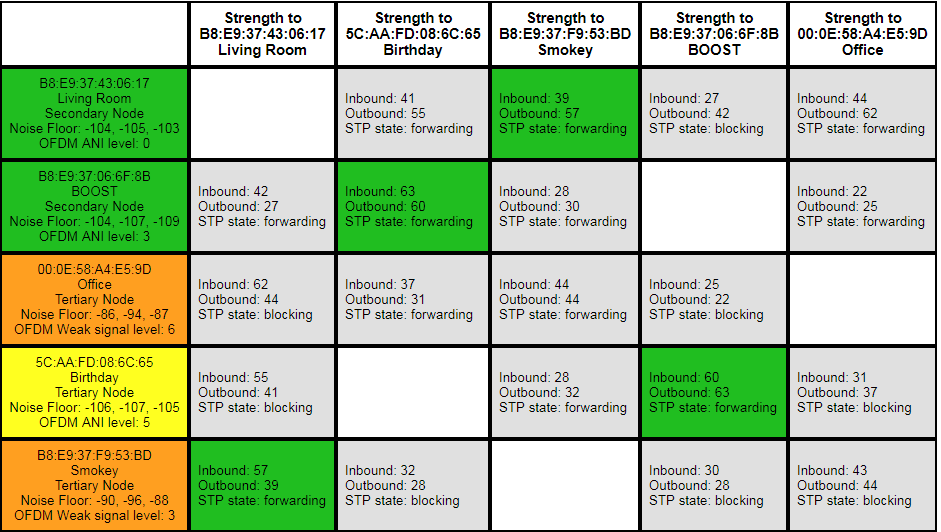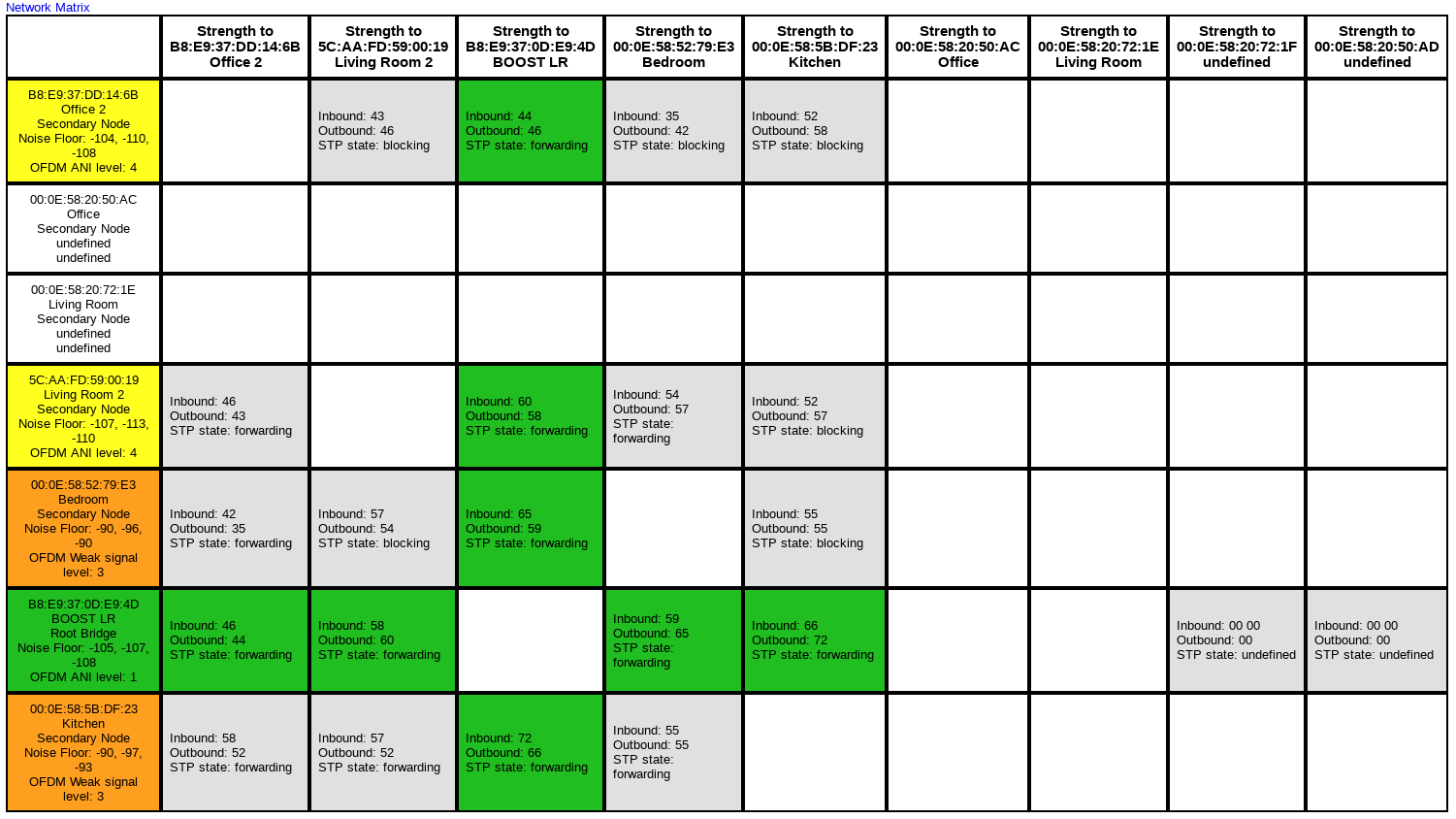Just brought up a network at home, and the matrix now looks terrible. Details below.
Something is clearly wrong. You can see in the attached matrix that there is no root device, and a lot of STP is blocked. Wired devices are turning up orange.
This Sonos system has “evolved” over 5 years and several routers, bridge swapped for boost, etc. I feel like it maybe needs a factory reset. There are a few settings in there I care about, but could live without (a couple of playlists, DSP tuning of the speakers). Here are the full details:
I'm using Sonos Net for the wireless. Here's the network topology:
Unifi USG router -> Unifi switch 8 (root switch).
root switch -> Sonos Boost.
root switch -> Playbase "Living Room"
root switch -> Unifi switch 8 (secondary switch).
secondary switch -> Sonos Connect (Office).
Sonos Play5 II, wireless, near boost (“Birthday”)
Sonos Play5 I, wireless, near connect (“Smoky”)
The Unifi switches are set up the recommended way for Sonos. Spanning tree is set to STP, and the priority is 4096 on the root switch, and 8192 on the secondary switch.
- Community
- Get help and assistance with your Sonos system
- Advanced setups
- 5 sonos devices on a Ubiquity Unifi network. Matrix looks terrible.
Question
5 sonos devices on a Ubiquity Unifi network. Matrix looks terrible.
- September 4, 2017
- 25 replies
- 3079 views
This topic has been closed for further comments. You can use the search bar to find a similar topic, or create a new one by clicking Create Topic at the top of the page.
25 replies
- Collaborator II
- September 5, 2017
I highly recommend either turn off SonosNet and use your household WiFi, or unplug two of the Connect, Boost or Playbase. You want either a single bridge to your wired network, or them all to run off of your network. The best way to use STP is to just avoid the loops to begin with. 🙂
- Author
- Enthusiast II
- September 5, 2017
BTW: there used to be posts here on how to reset all of this without doing a factory reset. But it seems that all the URLs changed on this forum, and now all the links to the magic article go nowhere.
- Author
- Enthusiast II
- September 5, 2017
That's a pretty draconian solution! Don't use all my devices is a non-starter. Don't use Sonosnet is interesting, but runs counter to all the discussion I've seen on this issue. All the posts I've seen claim that Sonosnet is much preferable to WiFi.
- Collaborator II
- September 5, 2017
SonosNet is isolated from the household WiFi, so it can work with its modest bandwidth requirements on iffy signals, and most people have poor WiFi coverage using fair to poor routers - that's then shared between all of their much more bandwidth hungry devices. If you don't have that problem (I have four Cisco WAPs... suffice it to say it drowns out anything Sonos can do), then it's really horses for courses. The fact that you have a Ubiquiti solution leads me to believe you're closer to my situation than the average user's. You can also use QoS on the WiFi to ensure a slice of bandwidth is always available to Sonos.
- September 5, 2017
I think @jec6613's suggestions are very reasonable, but your post prompts a number of thoughts:
1. Forget factory resetting, which would be utterly pointless in this situation
2. It is pretty clear that the "root switch" is acting as the root, hence no root in the matrix
3. No idea what you mean by setting up the switches in the recommended way for Sonos. Recommended by whom?
4. If you wish to continue to use SonosNet, wire the Boost to the router and go wireless with everything else. Going to standard setup is another possibility, as already mentioned by @jec6613
5. Nothing wrong with blocking, that is what STP is supposed to do
6. What channels are your router and SonosNet on?
7. If the wireless P:5 is close to the Boost, why not wire the P:5 instead of the Boost?
1. Forget factory resetting, which would be utterly pointless in this situation
2. It is pretty clear that the "root switch" is acting as the root, hence no root in the matrix
3. No idea what you mean by setting up the switches in the recommended way for Sonos. Recommended by whom?
4. If you wish to continue to use SonosNet, wire the Boost to the router and go wireless with everything else. Going to standard setup is another possibility, as already mentioned by @jec6613
5. Nothing wrong with blocking, that is what STP is supposed to do
6. What channels are your router and SonosNet on?
7. If the wireless P:5 is close to the Boost, why not wire the P:5 instead of the Boost?
- Author
- Enthusiast II
- September 5, 2017
Good points! But I still think something is wrong when the matrix is showing bad connections between two wired devices. Really looks like something is going wrong with STP here. I will try WiFi at some point, however.
- September 5, 2017
And incidentally, the orange indicates local interference, which, as the devices are wired, isn't really a concern. It would not surprise me if this system is actually functioning OK. What problems are you having?
- Author
- Enthusiast II
- September 5, 2017
Great points. And, I have to admit that as I'm scurrying around setting up network stuff, I haven't listened much today. But since I use the connect only to digitize my turntable and stream it uncompressed to the Play 5-II, I have historically had dropout issues. So I'm paranoid about connectivity to that unit.
I'm no expert at the "matrix", but all that STP port blockage worries me. I may be wrong, but it looks like STP is preventing the wired connect from using the wire.
But, yeah, I should just play a few records and see what happens.
- Author
- Enthusiast II
- September 5, 2017
1. Forget factory resetting, which would be utterly pointless in this situation
2. It is pretty clear that the "root switch" is acting as the root, hence no root in the matrix
3. No idea what you mean by setting up the switches in the recommended way for Sonos. Recommended by whom?
4. If you wish to continue to use SonosNet, wire the Boost to the router and go wireless with everything else. Going to standard setup is another possibility, as already mentioned by @jec6613
5. Nothing wrong with blocking, that is what STP is supposed to do
6. What channels are your router and SonosNet on?
7. If the wireless P:5 is close to the Boost, why not wire the P:5 instead of the Boost?
1,2 - tx.
3: On the Unify forum (and maybe here?) people say one should set these switches to "STP" rather than RSTP. And that the root switch should have a STP priority of 4096, and the secondary should be 8192.
4: Boost is on the primary switch, so I could try "unplugging" everything else. By "standard setup" do you mean Wifi rather than Sonosnet?
6: My Sonosnet is on channel 1, and my AP's are on 6 and 11.
7: I would very much like to wire my Play 5. It would be physically awkward in my house, but always a possibility.
thanks for the tips!
- September 5, 2017
I think you are wrong about the wired connection being blocked. I think Office is shown as tertiary because it is not getting its data directly from the root (the root switch) but from the secondary switch. The potential wireless paths to Living Room, Smokey and Birthday are all closed, as they should be.
IMO you are barking up the wrong tree completely with this network matrix stuff. Your real problem is that line-in uncompressed is dropping out, which could happen with the most healthy-looking matrix. The solution is to change to compressed - I bet you don't notice any change in sound quality, other than that caused by expectations bias!
IMO you are barking up the wrong tree completely with this network matrix stuff. Your real problem is that line-in uncompressed is dropping out, which could happen with the most healthy-looking matrix. The solution is to change to compressed - I bet you don't notice any change in sound quality, other than that caused by expectations bias!
- Author
- Enthusiast II
- September 5, 2017
hah - I'll bet you are right about all this. Although I'm still going to stick with uncompressed - it's always worked fine for me in the past. tx again.
- September 5, 2017
Your matrix looks fine to me. That's what I would expect it to look like with five devices, three of which are wired.
The yellow and orange in the left column indicate local noise near those devices, but the actual wireless links between devices are in good shape (they're green). While you mention that Smokey is close to Office, one of the links to Living Room is strong enough that it's preferring that route instead of going to Office. Maybe move it closer to one or the other, if possible, so the signals are stronger or weaker. The strong link between Smokey and Living Room is much stronger than the connections to Office... so it might be better to move closer to Living Room.
The yellow and orange in the left column indicate local noise near those devices, but the actual wireless links between devices are in good shape (they're green). While you mention that Smokey is close to Office, one of the links to Living Room is strong enough that it's preferring that route instead of going to Office. Maybe move it closer to one or the other, if possible, so the signals are stronger or weaker. The strong link between Smokey and Living Room is much stronger than the connections to Office... so it might be better to move closer to Living Room.
- Author
- Enthusiast II
- September 5, 2017
I'm getting a lot of good info from anyone. One Q: what does "green" mean in the matrix? Notice that every device seems to have one green path somewhere, except "office" who is wired to the secondary switch.
If green is good, I would expect office to have a green connection to someone wired (like Living Room, who is on the root switch).
If green is good, I would expect office to have a green connection to someone wired (like Living Room, who is on the root switch).
- Contributor I
- September 5, 2017
AFAIK the colors indicate wi-fi strength only. You don't get the "strength" of a wired connection in the matrix.
A suggestion (although unsupported, your own risk) would be to switch off wi-fi on the devices which have a permanent ethernet connection. Such devices show up in the matrix with an empty row.
A suggestion (although unsupported, your own risk) would be to switch off wi-fi on the devices which have a permanent ethernet connection. Such devices show up in the matrix with an empty row.
- Author
- Enthusiast II
- September 6, 2017
A suggestion (although unsupported, your own risk) would be to switch off wi-fi on the devices which have a permanent ethernet connection. Such devices show up in the matrix with an empty row.
Thanks! Learning a lot 🙂
- Lead Maestro
- September 6, 2017
- Contributor I
- September 29, 2017
I use managed switches and Unifi access points and have 10 Sonos devices 7 of which are wired and the other 3 are on Sonos Net. I use several switches set up as yours are with my main switch as the root bridge for STP.
Your Matrix looks fine. The blocking is expected. If there was not blocking you would have a network storm/flooding problem.
Don't reset anything nor switch the Sonos devices to your wifi! Leave it set up the way it is.
Are you having specific problems? What are they? If there is a specific issue let's try and solve that.
Your Matrix looks fine. The blocking is expected. If there was not blocking you would have a network storm/flooding problem.
Don't reset anything nor switch the Sonos devices to your wifi! Leave it set up the way it is.
Are you having specific problems? What are they? If there is a specific issue let's try and solve that.
- September 29, 2017
I've been repeatedly told by Sonos support that even in a fully wired network, speakers talk to each other over wifi, and that is used in paired and grouped playback, at the very least.
- September 29, 2017
mataglap,
Yes, SONOS units will always "talk" because they want to keep track of current wireless network conditions -- if only to know which links will not be productive. This is done in order to have the ability to quickly start using an alternate path if a current path goes down. The idea is to be able to find an alternate path without interrupting the music.
Yes, SONOS units will always "talk" because they want to keep track of current wireless network conditions -- if only to know which links will not be productive. This is done in order to have the ability to quickly start using an alternate path if a current path goes down. The idea is to be able to find an alternate path without interrupting the music.
- September 29, 2017
I'm not convinced paired or grouped playback would be fundamentally different in this respect, but I couldn't be totally confident on that.
- September 29, 2017
@buzz yes I was sloppy in saying "wifi" and not "SonosNet". But I'm not talking about the BDU packets. Can you say authoritatively that SonosNet communication between wired Sonos units is not used for other purposes?
I've been told that there is active "wireless" (presumably SonosNet) communication between fully wired players in paired and group playback situations. I couldn't get any more detail. Wireless interference has been cited by Support as an issue in my wired network when troubleshooting playback problems from my local library.
If there are aspects of the Sonos software that use SonosNet even when wired, then the conventional wisdom about turning off the wireless radio when cabled is at best misleading, and potentially introducing more problems.
I've been told that there is active "wireless" (presumably SonosNet) communication between fully wired players in paired and group playback situations. I couldn't get any more detail. Wireless interference has been cited by Support as an issue in my wired network when troubleshooting playback problems from my local library.
If there are aspects of the Sonos software that use SonosNet even when wired, then the conventional wisdom about turning off the wireless radio when cabled is at best misleading, and potentially introducing more problems.
- Lead Maestro
- September 29, 2017
There are a wealth of statistics available on the Sonos diagnostics pages that you could probably use to see just what is going on with your networking. I'm just not up for that level of effort as long as things are working here.
- October 1, 2017
In some respects this is a trick question.
SONOS will share its connection with any device plugged into one of its network ports. This could present a security problem if a hacker has physical access to a player because the network ports are on the local subnet. It's also a wonderful opportunity to provide a network connection to a device when there is no easy opportunity to run a wire -- just hook up to the nearest SONOS player. Don't go crazy with this sharing because you could swamp SonosNet with miscellaneous traffic. SonosNet is robust for audio, but shouldn't be used to support a video server with multiple simultaneous clients. I have successfully used SonosNet to support a TV running Netflix when the TV was in a spotty WiFi location.
A dedicated, well equipped hacker could probably break the SonosNet wireless security, but this is not a piece-of-cake project for the walk-by teen prankster. It would be much easier to prank the local WiFi. An Android device can use SonosNet rather than WiFi (after setup via WiFi).
Enter your E-mail address. We'll send you an e-mail with instructions to reset your password.
Scanning file for viruses.
Sorry, we're still checking this file's contents to make sure it's safe to download. Please try again in a few minutes.
OKThis file cannot be downloaded
Sorry, our virus scanner detected that this file isn't safe to download.
OK





